Livio Senigalliesi – Photo by Silvia Amodio
It was not easy to succumb to the temptation to write an article about Livio Senigalliesi. Especially about the war, its horror and its endless repercussions on civilians. This blog post is not about such serious topics. I made the decision after meeting him here in Sardinia as a simple tourist who enjoys the view from the cliffs of the Iglesiente coastline. I spent time with him talking about my Island.

He was not there by chance in front of Laveria La Marmora di Nebida, but to build his new work. A report that talks about mines, memory and men in struggle and brotherhood. As a gentleman with a white beard, a camera around his neck, and with eyes of one who can immediately grasp the true meaning of things and of places.
I cannot say that from that day we have become close friends, but today I consider him a person to whom I feel very connected. With him I occasionally share a few chats about Sardinia, our projects and what has always been his real work and that, undoubtedly also marked his life. His travel have been very different from that of a common tourist. The places he have visited are the battlefields that have followed one another in the last decades all over the globe. From Africa, with the massacres that seem so distant to the Western world. To our Europe, torn apart only a few decades ago by the genocides of the former Yugoslavia, a place that is also very familiar to me. A multi-ethnic land that a blindly guilty Europe let torture by a handful of assassins in the name of nationalism. But there is one thing that struck me in Livio’s words, especially when I read his book “Memories of a War Reporter“, and it is that phrase that comes back to my mind every time: “Wars are a means of destruction and erasure of memory “.

And isn’t it true? The horror is like the fog that hangs over the places, events and memories of a people. Assassinate, rape, and exile thousands of people. It is not only a simple and atrocious gesture, but above all the best way to break and bury that chain of memories that form a collective memory. Which once erased, also it makes the traces of that community disappear. It is the history of the human race after all, and Livio is a living witness, becoming with his photos and his texts, the medium that brings that memory back to the surface and keeps it alive. Some might think of how adrenaline filled the job of a war reporter is. Always around the world, a life of action as Hemingway.
Very fascinating in Hollywood movies, but the downside is that all this is quite difficult and hard in real life. Because when you come home, those images of cruelty do not just remain printed on the photos, but become a part of your life, driving you away like a prey wounded to death. Your only hope is therefore to return to those places, to exorcise that horror. Taking the onerous burden of witnessing how difficult it is to think of a human race that can really materialise peace. Today Livio no longer frequents the battlefields, but his life, his work itself, are still closely connected with war. They are the photographic exhibitions, the books, but above all informative events in the schools, which is his new mission.

Making young people understand, those who in the future will hold the reins of a nation, the tragic errors of our past, what war is and what a true global peace could be. I am sure that these good times spent raising awareness among these young people will always keep them busy. For my part, I hope that part of that horror, told with such raw lucidity, will disappear forever from his eyes. Now Sardinia is waiting for it. It waits for Livio as one of those illustrious travellers who have left a precious testimony of our culture in their journals.
See you soon in Sardinia, Livio